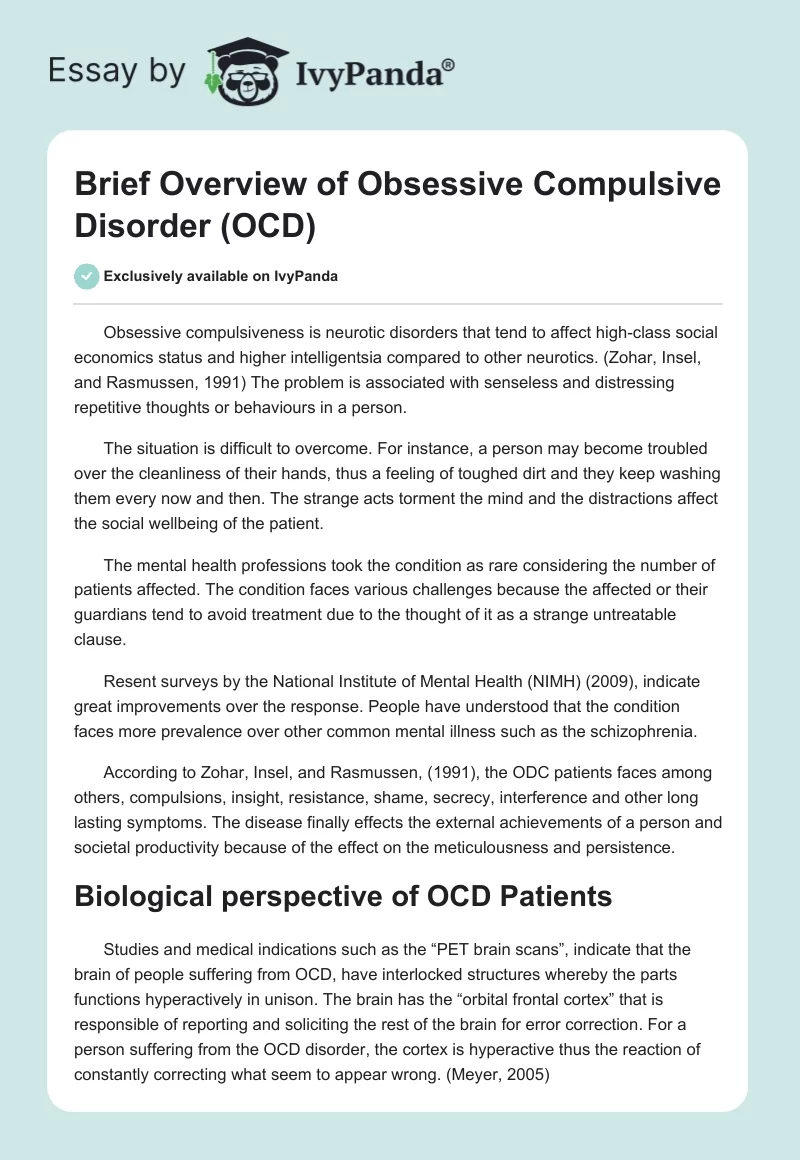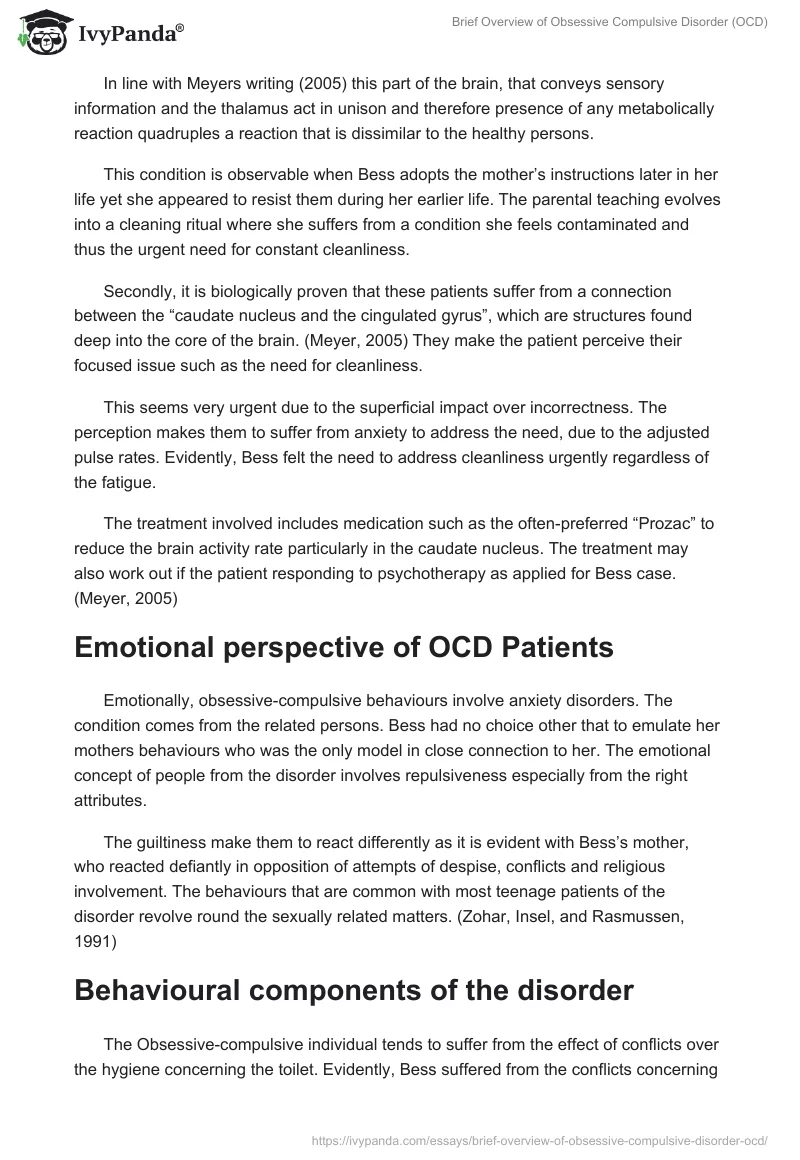Obsessive compulsiveness is neurotic disorders that tend to affect high-class social economics status and higher intelligentsia compared to other neurotics. (Zohar, Insel, and Rasmussen, 1991) The problem is associated with senseless and distressing repetitive thoughts or behaviours in a person.
The situation is difficult to overcome. For instance, a person may become troubled over the cleanliness of their hands, thus a feeling of toughed dirt and they keep washing them every now and then. The strange acts torment the mind and the distractions affect the social wellbeing of the patient.
The mental health professions took the condition as rare considering the number of patients affected. The condition faces various challenges because the affected or their guardians tend to avoid treatment due to the thought of it as a strange untreatable clause.
Resent surveys by the National Institute of Mental Health (NIMH) (2009), indicate great improvements over the response. People have understood that the condition faces more prevalence over other common mental illness such as the schizophrenia.
According to Zohar, Insel, and Rasmussen, (1991), the ODC patients faces among others, compulsions, insight, resistance, shame, secrecy, interference and other long lasting symptoms. The disease finally effects the external achievements of a person and societal productivity because of the effect on the meticulousness and persistence.
Biological perspective of OCD Patients
Studies and medical indications such as the “PET brain scans”, indicate that the brain of people suffering from OCD, have interlocked structures whereby the parts functions hyperactively in unison. The brain has the “orbital frontal cortex” that is responsible of reporting and soliciting the rest of the brain for error correction. For a person suffering from the OCD disorder, the cortex is hyperactive thus the reaction of constantly correcting what seem to appear wrong. (Meyer, 2005)
In line with Meyers writing (2005) this part of the brain, that conveys sensory information and the thalamus act in unison and therefore presence of any metabolically reaction quadruples a reaction that is dissimilar to the healthy persons.
This condition is observable when Bess adopts the mother’s instructions later in her life yet she appeared to resist them during her earlier life. The parental teaching evolves into a cleaning ritual where she suffers from a condition she feels contaminated and thus the urgent need for constant cleanliness.
Secondly, it is biologically proven that these patients suffer from a connection between the “caudate nucleus and the cingulated gyrus”, which are structures found deep into the core of the brain. (Meyer, 2005) They make the patient perceive their focused issue such as the need for cleanliness.
This seems very urgent due to the superficial impact over incorrectness. The perception makes them to suffer from anxiety to address the need, due to the adjusted pulse rates. Evidently, Bess felt the need to address cleanliness urgently regardless of the fatigue.
The treatment involved includes medication such as the often-preferred “Prozac” to reduce the brain activity rate particularly in the caudate nucleus. The treatment may also work out if the patient responding to psychotherapy as applied for Bess case. (Meyer, 2005)
Emotional perspective of OCD Patients
Emotionally, obsessive-compulsive behaviours involve anxiety disorders. The condition comes from the related persons. Bess had no choice other that to emulate her mothers behaviours who was the only model in close connection to her. The emotional concept of people from the disorder involves repulsiveness especially from the right attributes.
The guiltiness make them to react differently as it is evident with Bess’s mother, who reacted defiantly in opposition of attempts of despise, conflicts and religious involvement. The behaviours that are common with most teenage patients of the disorder revolve round the sexually related matters. (Zohar, Insel, and Rasmussen, 1991)
Behavioural components of the disorder
The Obsessive-compulsive individual tends to suffer from the effect of conflicts over the hygiene concerning the toilet. Evidently, Bess suffered from the conflicts concerning these sanitary issues. The experts link the hygiene issues to the theory of the patient tending to remain in one “anal-sadistic stage of development”. (Meyer, 2005)
Argumentatively, these recurrences of the toilet sanitation concerns may come about because it is one of the sources of conflict between the mother and the child during development. It is also a stage when the child tries to integrate and model parental behaviours. The child has to consider the concerns and rulings thus their probability of being key aspects connected to OCD.
Most of the OCD patients’ behaviours emerge from the parents whereby one main concern would be intellectualization as a means of dealing with anxiety. This involves concern over key issues that led to conflicts in the aim of avoiding the impact they have.
It works perfectly in the school or work settings and unmistakably it did wonders for Bess when she took her mother’s advice during her school work as well as career tasks but created conflicts when it was done contradictory at home.
The patients have to struggle and maintain their obsessive –compulsive indicators under control by casting the compulsive throughout during the work or school time. The resistance however weakens overtime and the behaviours become severe. This is the reason why such a people engage in time-consuming rituals that overcome real life. Bess’ case has this evidential aspect.
In line with the case study, Bess’s social life is highly affected by her condition, manifested in the lack of activity in her life. She often works late and lives alone thus being forcing her to live a lonely lifestyle. Medically, a person suffers from the ODC when their compulsive and obsessive behaviour becomes extreme to the point of interfering with the normal lifestyle. (Meyer, 2005) According to Bess case, Sleep is a complicated phenomenon in her life to the extent that, she has to do with pills or alcohol to find some.
Conclusion
The symptoms of OCD begin during childhood and the process of coping with the embarrassment-involved causes the victim to hide the compulsions and thus the stress evidenced later in life. The process of successfully concealing these problems from friend, relatives or co-workers other than seeking help requires remarkable ability.
The unfortunate consequence of the secrecy becomes evident later on in their lives when medical assistance is inevitable. At this later stage, the compulsive habits are subterranean or profoundly ingrained and often difficult to transform.
Children suffering from the disorder are more prone to other psychiatric conditions such as panic disorders, phobia of being social, learning disorders, hatred, and depression. (Meyer, 2005) This was evident on the case study where Bess remains enclosed in her own cocoon lifestyle.
The biggest challenge to psychoanalysis regarding the problem is the fact that the individual is highly involved in intellectualization, which they use as a protection mechanism. The most recommended treatment therapy revolves round responsive prevention that involves relationship.
The modification of behaviour through cognition unlocks the brain’s caudate nucleus structure and enables the patient to rebel urges as opposed to giving in. It calls for engagement on extra curricular activities to divert the attention and urge. (Meyer, 2005) The patient has to be guided to enable them understand the problem and this facilitates the ability to come up with mechanisms of fight the problem. The main aim of the therapy is to distort the behaviour to a more enjoyable and productive activity and lifestyle.
References
Meyer, R.G. (2005). Case Studies in Abnormal Behaviour. (Seventh Edition). Upper Saddle.
River, NJ: Pearson Education Publishers National Institute of Mental Health (NIMH). (2009). Obsessive Compulsive Disorder. Web.
Zohar, J., Insel, T.R., and Rasmussen, S. (1991). Psychobiology of Obsessive-Compulsive Disorder. New York: Springer Publishing Co.


